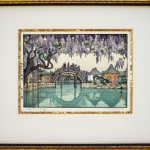Toshi Yoshida Japanese, 1911-1995
protected by museum glass
Further images
This exquisite woodblock print, titled Half Moon Bridge, was created by Toshi Yoshida, one of Japan’s most celebrated 20th-century artists and a master of the shin-hanga (“new prints”) movement. Yoshida’s work blends traditional Japanese printmaking techniques with a refined modern sensibility, capturing both atmosphere and architectural harmony with precision and grace.
The composition centres on a graceful arched bridge, its perfect semicircular form mirrored in the still turquoise water below—hence the title “Half Moon.” A procession of visitors, dressed in bright kimonos and Western attire, crosses the bridge, pausing to admire the serene view. Overhead, cascading wisteria blossoms frame the scene in soft lavender hues, their drooping clusters adding rhythm and intimacy to the composition. To the right, traditional Japanese pavilions and shrines rise elegantly, their muted greys and ochres contrasting with the brilliant floral canopy.
The print exemplifies Yoshida’s hallmark characteristics: precise linework, subtle gradations of colour, and a delicate balance between man-made and natural beauty. The reflection of the bridge forms a complete circle on the water’s surface, symbolising harmony and continuity, while the figures introduce a gentle liveliness into an otherwise meditative setting.
Created in the post-war period, Half Moon Bridge reflects Yoshida’s fascination with tranquil garden landscapes and the universal beauty of Japanese design. Its meticulous craftsmanship and lyrical composition make it one of the most poetic and recognisable examples of mid-century shin-hanga artistry.
Provenance
- reissued by estate after death in 1995- private collection, Toronto






